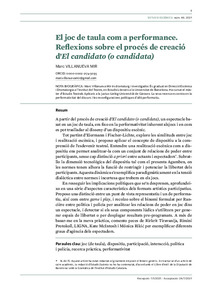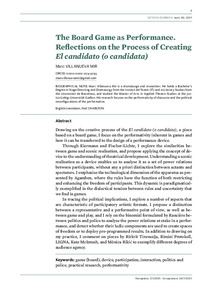| dc.contributor.author | Villanueva Mir, Marc | |
| dc.date.accessioned | 2022-11-30T11:04:18Z | |
| dc.date.available | 2022-11-30T11:04:18Z | |
| dc.date.issued | 2021 | |
| dc.identifier.issn | 2385-362X | |
| dc.identifier.issn | 0212-3819 | |
| dc.identifier.uri | http://hdl.handle.net/20.500.11904/1261 | |
| dc.description.abstract | <p>A partir del procés de creació d’<em>El candidato (o candidata)</em>, un espectacle basat en un joc de taula, em fixo en la performativitat inherent alsjocs i en com es pot traslladar al disseny d’un dispositiu escènic.</p>
<p>Tot partint d’Eiermann i Fischer-Lichte, exploro les similituds entre joc i realització escènica, i proposo aplicar el concepte de dispositiu a la comprensió de l’esdevenir teatral. Entendre una realització escènica com a dispositiu ens permet analitzar-la com un conjunt de relacions de poder entre participants, sense cap distinció <em>a priori </em>entre actants i espectadors*. Subratllo la dimensió tecnològica del dispositiu tal com el presenta Agamben, on les normes tenen alhora la funció de restringir i potenciar la llibertat dels participants. Aquesta dinàmica s’exemplifica paradigmàticament en la tensió dialèctica entre normes i incertesa que trobem en els jocs.</p>
<p>En resseguir les implicacions polítiques que se’n desprenen, aprofundeixo en una sèrie d’aspectes característics dels formats artístics participatius. Proposo una distinció entre un punt de vista representatiu i un de performatiu, així com entre <em>game </em>i <em>play</em>, i recolzo sobre el binomi formulat per Rancière entre política i policia per analitzar les relacions de poder en joc dins un espectacle, i detectar si els seus components lúdics s’utilitzen per generar espais de llibertat o per desplegar resultats pre-programats. A més de basar-me en la meva pràctica, comento peces de Rirkrit Tiravanija, Rimini Protokoll, LIGNA, Kate McIntosh i Mónica Rikić per exemplificar diferents graus d’agència dels espectadors.</p> | |
| dc.description.abstract | <p>Drawing on the creative process of the <em>El candidato (o candidata)</em>, a piece based on a board game, I focus on the performativity inherent in games and how it can be transferred to the design of a performance device.</p>
<p>Through Eiermann and Fischer-Lichte, I explore the similarities between game and scenic realisation, and propose applying the concept of device to the understanding of theatrical development. Understanding a scenic realisation as a device enables us to analyse it as a set of power relations between participants, without any a priori distinction between actants and spectators. I emphasise the technological dimension of the apparatus as presented by Agamben, where the rules have the function of both restricting and enhancing the freedom of participants. This dynamic is paradigmatically exemplified in the dialectical tension between rules and uncertainty that we find in games.</p>
<p>In tracing the political implications, I explore a number of aspects that are characteristic of participatory artistic formats. I propose a distinction between a representative and a performative point of view, as well as between game and play, and I rely on the binomial formulated by Rancière between politics and police to analyse the power relations at stake in a performance, and detect whether their ludic components are used to create spaces of freedom or to deploy pre-programmed results. In addition to drawing on my practice, I comment on pieces by Rirkrit Tiravanija, Rimini Protokoll, LIGNA, Kate McIntosh, and Mónica Rikić to exemplify different degrees of audience agency. </p> | |
| dc.relation.ispartof | Estudis escènics: quaderns de l'Institut del Teatre. 2021, Núm. 46 | |
| dc.title | El joc de taula com a performance. Reflexions sobre el procés de creació d’«El candidato (o candidata)» | |
| dc.type | Article | |
| dc.date.updated | 2022-11-30T11:04:19Z | |
| dc.rights.access | Open Access | |



